ca:
CARREGAR (c) Peces decorades
es:
CARGAR (c) Piezas decoradas
Packing decorated work: Great care must be taken so that the kiln and the work being fired are not damaged in any way. Slip and glazes must not touch anything, each other, the walls of the kiln, the floor or shelves, furniture, etc. when being fired. All the parts or the footings which they stand on must be cleaned of glaze, since it acts as a glue and when fired will weld on to any object it touches and make it impossible to separate without damaging the work. Read more about: Kiln – Furniture
 Packing Plates
Packing Plates
a) Packing – with the danger of glaze running:
Should there be any danger of a glaze or color running, put the vessel on top of 3 or 4 bits and put these on a bisque tile. The tile will stop the floor of your kiln being damaged and if the glaze runs into the space made by the bits, will make it easier to twist and separate the pieces.
b) Plate supports: There are many types of cranks for plates and tiles, these are good if the plates and tiles you wish to fire are made with molds and therefore all the same size, but if handmade and varying in size, they are more difficult to fit in.
c) Tile shelves take up more room but are quicker and safer. They are made up with bisque tiles cut to the required sizes and are supported by tube props. Stilts and spurs can be used, but as putting them on top or under a plate always damages the glaze, the work will have to be repaired and repaired work is never perfect.
 Packing Pots and Lids When decorated it is difficultto to move them without touching and damaging the decoration, some lids are designed so the flange is high enough to put your fingers under the lip to move them. If picked up and a part that is decorated is touched it will have to be repaired when it is in the kiln.
Packing Pots and Lids When decorated it is difficultto to move them without touching and damaging the decoration, some lids are designed so the flange is high enough to put your fingers under the lip to move them. If picked up and a part that is decorated is touched it will have to be repaired when it is in the kiln.
d) The best way is to put the pots and the lids on top of a bisque tile that has been cut down to the size needed; it can be moved, using the tile like a tray and does not have to be touched throughout the whole process, from decorating on the wheel to putting the tile into the kiln as a tile shelf.
e) Pots can be moved by putting your hand inside the neck and using the pressure of your finger against the inside of the neck to lift and move them.
f) Lids, as they are short can be built up one top of the other, using tile shelves with tube prop, to support them.
Packing Tiles
 Tile stands also known as cranks, the illustration shows two types of tile stands.
Tile stands also known as cranks, the illustration shows two types of tile stands.
g) is dismountable.
h) is in one piece. For kilns that open at the side both can be used but for those that open at the top, the second is more convenient as it can be lifted up and put down into the kiln.
A big problem with tile stands is fitting them into your kiln without wasting space. Make sure when you buy a kiln that there is enough room to stand one on top of another. One of the disadvantages of standsnts for different sized tiles is that they are of different heights and this makes building up floors complicated. Kilns that open at the top have to be packed from above, so the large tile stands must be made in one piece. They have to be held at the top and lowered into the kiln. If your kiln opens from the front, other types of stands can be used. If you work with tiles a lot, you should have numerous stands, so when you have finished painting, the tiles can put directly into them, thus avoiding the damage that occurs when moving them from one place to another. The less you touch and move your finished work, the better.
 i) Small separate wall-stands: These are handmade to hold from two to four tiles of any size. They are short because they are separate and have to be held together securely when being moved. They are used mainly for packing borders 7,5 × 15cm, corners 7,5 × 7,5cm, and to fill up the leftover spaces when packing. In the section on molds, how to make them is explained.
i) Small separate wall-stands: These are handmade to hold from two to four tiles of any size. They are short because they are separate and have to be held together securely when being moved. They are used mainly for packing borders 7,5 × 15cm, corners 7,5 × 7,5cm, and to fill up the leftover spaces when packing. In the section on molds, how to make them is explained.
Read more about: Cranks / Cranks – Putting tiles in cranks / Cranks – Walls / Mold: 5 Hand made cranks

 Packing Plates
Packing Plates Packing Pots and Lids When decorated it is difficultto to move them without touching and damaging the decoration, some lids are designed so the
Packing Pots and Lids When decorated it is difficultto to move them without touching and damaging the decoration, some lids are designed so the  Tile stands also known as
Tile stands also known as  i) Small separate wall-stands: These are handmade to hold from two to four tiles of any size. They are short because they are separate and have to be held together securely when being moved. They are used mainly for packing borders 7,5 × 15cm, corners 7,5 × 7,5cm, and to fill up the leftover spaces when packing. In the section on molds, how to make them is explained.
i) Small separate wall-stands: These are handmade to hold from two to four tiles of any size. They are short because they are separate and have to be held together securely when being moved. They are used mainly for packing borders 7,5 × 15cm, corners 7,5 × 7,5cm, and to fill up the leftover spaces when packing. In the section on molds, how to make them is explained.  Packing kilns that open at the top; use tile stands which are made in one piece, these shown in the photos below, hold 14 tiles of 15 × 15cm, and wall-stands that are in two pieces and can hold tiles of all sizes. Here they are holding corner tiles of 7, 5 × 7, 5cm and borders of 7, 5 × 15cm. They are short, so they can be held and are handmade to hold from one to six tiles.
Packing kilns that open at the top; use tile stands which are made in one piece, these shown in the photos below, hold 14 tiles of 15 × 15cm, and wall-stands that are in two pieces and can hold tiles of all sizes. Here they are holding corner tiles of 7, 5 × 7, 5cm and borders of 7, 5 × 15cm. They are short, so they can be held and are handmade to hold from one to six tiles.  Paddle (and anvil):
Paddle (and anvil): Palette knife: the word knife leads you to think that this instrument is used for cutting but a palette knife cannot. It is metal, has a flat, thin, flexible blade with a half circular end, to a misunderstanding as it means it can cut and a palette knife cannot. It is metal, has a flat, thin, flexible blade with a half circular end, which is attached to a handle. The drawings on the right show ones with different shapes and the only part that is curved is the neck that connects the handle to the blade. They are made in different sizes and used for mixing, blending, cleaning, grinding down colors and stains and other products.
Palette knife: the word knife leads you to think that this instrument is used for cutting but a palette knife cannot. It is metal, has a flat, thin, flexible blade with a half circular end, to a misunderstanding as it means it can cut and a palette knife cannot. It is metal, has a flat, thin, flexible blade with a half circular end, which is attached to a handle. The drawings on the right show ones with different shapes and the only part that is curved is the neck that connects the handle to the blade. They are made in different sizes and used for mixing, blending, cleaning, grinding down colors and stains and other products.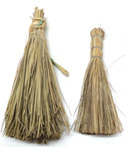 Palm brush is a brush made with leaves from palm trees. This brush has the form shown in the two photos and can be made in different sizes. If the brush is new, soak it in water, as the older and more used the brush, the better. Knock it about a bit to give it an uneven texture. It can be used for dusting the bisque and is very good for making uneven textures with glaze and colors.
Palm brush is a brush made with leaves from palm trees. This brush has the form shown in the two photos and can be made in different sizes. If the brush is new, soak it in water, as the older and more used the brush, the better. Knock it about a bit to give it an uneven texture. It can be used for dusting the bisque and is very good for making uneven textures with glaze and colors.  Paper cutters are machines to chop unwanted paper into small pieces. There are many types and a small electric one is easy to use and not expensive. Cut down paper is very useful for packing delicate ceramic objects.
Paper cutters are machines to chop unwanted paper into small pieces. There are many types and a small electric one is easy to use and not expensive. Cut down paper is very useful for packing delicate ceramic objects. 1) Pencil is a slender tube of wood containing a thin center of lead or a coloring material and is used for writing and drawing.
1) Pencil is a slender tube of wood containing a thin center of lead or a coloring material and is used for writing and drawing.  Pestle is a tool used for breaking down solid products by hand. Some are made of wood but the best have a wooden handle and stone head. They are usually sold with a mortar which is a bowl made in china or stone.
Pestle is a tool used for breaking down solid products by hand. Some are made of wood but the best have a wooden handle and stone head. They are usually sold with a mortar which is a bowl made in china or stone.  Photo Ceramic is the name used to refers to the process of applying photos onto ceramics. The first tests were carried out in France by Lafon de Camarsac (1821-1905), starting in 1851. Their novelty consisted in finding the way to produce a coat of ceramic colors which when vitrified became a permanent image. It was made to use with jewelry, watches and portraits replacing “painting on enamel”, which was a very complex method as the work had to be perfect and very small in size. At this time they also began using it in graveyards as it was particularly durable in adverse weather conditions and over time. Mathieu Deroche, Lafon de Camarsac and Guyot were the best known photo ceramists during this era, capable of creating photographic portraits with artistic dimensions, due to their training as miniature portrait painters on enamel.
Photo Ceramic is the name used to refers to the process of applying photos onto ceramics. The first tests were carried out in France by Lafon de Camarsac (1821-1905), starting in 1851. Their novelty consisted in finding the way to produce a coat of ceramic colors which when vitrified became a permanent image. It was made to use with jewelry, watches and portraits replacing “painting on enamel”, which was a very complex method as the work had to be perfect and very small in size. At this time they also began using it in graveyards as it was particularly durable in adverse weather conditions and over time. Mathieu Deroche, Lafon de Camarsac and Guyot were the best known photo ceramists during this era, capable of creating photographic portraits with artistic dimensions, due to their training as miniature portrait painters on enamel. Pierced decoration refers to holes cut into jars and plates as a decoration. Once the clay is leather-hard it can be pierced. Strong, sharp bladed tools and hole boring implements are needed for pierced decoration. The pattern should be worked out in advance and marked onto the dry clay.
Pierced decoration refers to holes cut into jars and plates as a decoration. Once the clay is leather-hard it can be pierced. Strong, sharp bladed tools and hole boring implements are needed for pierced decoration. The pattern should be worked out in advance and marked onto the dry clay. Piggy bank is used to save money; it is a ceramic money box which is hollow and made in the shape of a pig. On the top there is a narrow, open space through which coins can be dropped. Nowadays, they can be bought with a hole underneath and a cork to block it, so they can be emptied. In the past they were made without this and had to be broken to be emptied.
Piggy bank is used to save money; it is a ceramic money box which is hollow and made in the shape of a pig. On the top there is a narrow, open space through which coins can be dropped. Nowadays, they can be bought with a hole underneath and a cork to block it, so they can be emptied. In the past they were made without this and had to be broken to be emptied. Pin-pencil is used to make holes into the drawing you want to mark onto ceramic ware. The method of marking these holes is known as
Pin-pencil is used to make holes into the drawing you want to mark onto ceramic ware. The method of marking these holes is known as  Pinching is one of the oldest methods of giving shape to clay and here it is covered in two sections, of which this is the first. There are many illustrationsat the end of the section;
Pinching is one of the oldest methods of giving shape to clay and here it is covered in two sections, of which this is the first. There are many illustrationsat the end of the section; Pinching a bowl that has been started with coils.
Pinching a bowl that has been started with coils.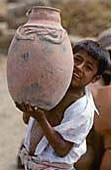 Primitive firings were made up with wood, coal, sawdust, paper, smoking, in holes the clay pieces they madein the ground, cans, manure, etc. They did not have kilns but built up large outdoor bonfires, which covered the clay pieces they made. The bonfire was made up with combustible material and was usually in an area near where people lived. The bonfires never reached very high temperatures, the heat for firing wasusually around 700° C. The colors of the pieces were irregular as this depended on the intensity of the heat in each zone of the kiln.
Primitive firings were made up with wood, coal, sawdust, paper, smoking, in holes the clay pieces they madein the ground, cans, manure, etc. They did not have kilns but built up large outdoor bonfires, which covered the clay pieces they made. The bonfire was made up with combustible material and was usually in an area near where people lived. The bonfires never reached very high temperatures, the heat for firing wasusually around 700° C. The colors of the pieces were irregular as this depended on the intensity of the heat in each zone of the kiln. The firing of clay started thousands of years ago. At first the work was left in the sun to dry, then primitive man realized that the hotter it got the stronger it became and started using bonfires. The first evolution was pit firing it’s one of the oldest methods of firing; pits are spaces in the ground, they can be a natural formation or dug out by hand.
The firing of clay started thousands of years ago. At first the work was left in the sun to dry, then primitive man realized that the hotter it got the stronger it became and started using bonfires. The first evolution was pit firing it’s one of the oldest methods of firing; pits are spaces in the ground, they can be a natural formation or dug out by hand.  Plate: Comes from the word “plata” which means silver in Latin. It originally described flat pieces of silver, which the rich ate off. When ceramics became commercial, the word changed and became “plate”. The word plate has many different meanings but when used in ceramics it applies to dishes made to use in relation to food, side plate, serving plate, soup plate, etc. and can be made of earthenware or porcelain.
Plate: Comes from the word “plata” which means silver in Latin. It originally described flat pieces of silver, which the rich ate off. When ceramics became commercial, the word changed and became “plate”. The word plate has many different meanings but when used in ceramics it applies to dishes made to use in relation to food, side plate, serving plate, soup plate, etc. and can be made of earthenware or porcelain.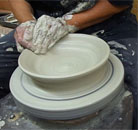 Plate throwing: Everything to do with the first stages of working on the wheel with clay can be found in six files:
Plate throwing: Everything to do with the first stages of working on the wheel with clay can be found in six files:  *Plate setters*are industrially made table stands that hold decorated plates when being fired. They have three legs and are designed to stand one on top of the other.
*Plate setters*are industrially made table stands that hold decorated plates when being fired. They have three legs and are designed to stand one on top of the other. Plate shelves: are made with a curve to hold plates, they save space and are good if you work with many plates that have the same shape. They are built up using tube props to form bridges one on top of another
Plate shelves: are made with a curve to hold plates, they save space and are good if you work with many plates that have the same shape. They are built up using tube props to form bridges one on top of another 
 Plunge Pot is a pot formed by pressing a solid object, like a round or square pole of wood, into a block of clay. This forms the center then the outer part can be shaped by slicing, beating, etc.
Plunge Pot is a pot formed by pressing a solid object, like a round or square pole of wood, into a block of clay. This forms the center then the outer part can be shaped by slicing, beating, etc. History: Porcelain paste is of Chinese origin. It is said that Chinese ceramists prepared mountains of porcelain for their grandchildren and left it exposed to the elements for two generations so it became more plastic, this was approximately 1500 years ago.
History: Porcelain paste is of Chinese origin. It is said that Chinese ceramists prepared mountains of porcelain for their grandchildren and left it exposed to the elements for two generations so it became more plastic, this was approximately 1500 years ago. Porosity: is the amount of water fired clay can absorb. Clay in the plastic state has different particles filled with water and when fired to 600ºC it is transformed and becomes ceramic and is known as bisque. The spaces left where the particles have burnt away make the bisque very porous.
Porosity: is the amount of water fired clay can absorb. Clay in the plastic state has different particles filled with water and when fired to 600ºC it is transformed and becomes ceramic and is known as bisque. The spaces left where the particles have burnt away make the bisque very porous.  Pot lifts provide an easy method for removing thrown pots from the wheel without damage. They are made from stainless, high-strength aircraft aluminum alloy and are available in three sizes to fit a wide range of pottery shapes.
Pot lifts provide an easy method for removing thrown pots from the wheel without damage. They are made from stainless, high-strength aircraft aluminum alloy and are available in three sizes to fit a wide range of pottery shapes.  Pot, also known as jar, is a ceramic product made to hold many different products such as earth, flowers, herbs, food, sugar and salt. It can be any size, from a large flower pot for a garden to a small salt pot for the table. It always has an opening at the top and can be with or without a lid.
Pot, also known as jar, is a ceramic product made to hold many different products such as earth, flowers, herbs, food, sugar and salt. It can be any size, from a large flower pot for a garden to a small salt pot for the table. It always has an opening at the top and can be with or without a lid. 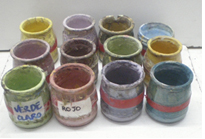 Pots for colors are usually small glass yoghurt pots used for keeping prepared colors. These pots are marked with insulating tape, each painter has a different color so he knows which ones are his. If there are very similar colors, they are named.
Pots for colors are usually small glass yoghurt pots used for keeping prepared colors. These pots are marked with insulating tape, each painter has a different color so he knows which ones are his. If there are very similar colors, they are named.  A pot or jar for cleaning paint brushes should be made of glass, be large and have a wide opening. The inside walls should be kept very clean so you can see how dirty the water is. As the dirty water adheres and dries on the inside of the glass it becomes impossible to see if the water is clean or dirty. Water carried on brushes can affect the colors you are using.
A pot or jar for cleaning paint brushes should be made of glass, be large and have a wide opening. The inside walls should be kept very clean so you can see how dirty the water is. As the dirty water adheres and dries on the inside of the glass it becomes impossible to see if the water is clean or dirty. Water carried on brushes can affect the colors you are using. 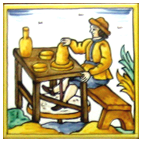 Potter: the word originally referred to the person who made ceramic pots and now applies to a person who works in any form of handmade ceramics, working with clay, decorating in one of the hundreds of different methods there are. The illustration shows six hand painted tiles illustrating the working process.
Potter: the word originally referred to the person who made ceramic pots and now applies to a person who works in any form of handmade ceramics, working with clay, decorating in one of the hundreds of different methods there are. The illustration shows six hand painted tiles illustrating the working process. Flameproof ware applies to pottery products prepared to take direct heat from open fires and gas. In many Mediterranean countries this has been used for many centuries.
Flameproof ware applies to pottery products prepared to take direct heat from open fires and gas. In many Mediterranean countries this has been used for many centuries.  Pouncing is to prick holes Pouncing is to prick holes through the outlines of a design so it can be marked on to another object. Lay a thin piece of cloth over a hard surface. The cloth should be just thick enough to let the point of the pin go through the paper. Flip over the tracing paper with the design marked on so the back is facing up and lay it on top of the cloth. Pounce holes through the outlines with a
Pouncing is to prick holes Pouncing is to prick holes through the outlines of a design so it can be marked on to another object. Lay a thin piece of cloth over a hard surface. The cloth should be just thick enough to let the point of the pin go through the paper. Flip over the tracing paper with the design marked on so the back is facing up and lay it on top of the cloth. Pounce holes through the outlines with a  Pouring is a way of putting a glaze or slip on to pottery. It is the method used to cover a piece of clay or bisque by tipping the liquid over the piece prepared. Here it explains how to use it with jars and bowls and tiles are in the section
Pouring is a way of putting a glaze or slip on to pottery. It is the method used to cover a piece of clay or bisque by tipping the liquid over the piece prepared. Here it explains how to use it with jars and bowls and tiles are in the section  Protractor is a flat, semicircular instrument made of transparent plastic with graduating degrees marked onto it and used for measuring and drawing angles.
Protractor is a flat, semicircular instrument made of transparent plastic with graduating degrees marked onto it and used for measuring and drawing angles.  Pulling to make a handle. Hold the clay in both hands; pull it downwards with your right hand, slowly and evenly to make it into a long round cylinder, then press and indent it for shape and form. This can then be attached to the main body of the piece to form a handle. Another way to make a handle is to attach the clay to the jar first and then pull it.
Pulling to make a handle. Hold the clay in both hands; pull it downwards with your right hand, slowly and evenly to make it into a long round cylinder, then press and indent it for shape and form. This can then be attached to the main body of the piece to form a handle. Another way to make a handle is to attach the clay to the jar first and then pull it. 